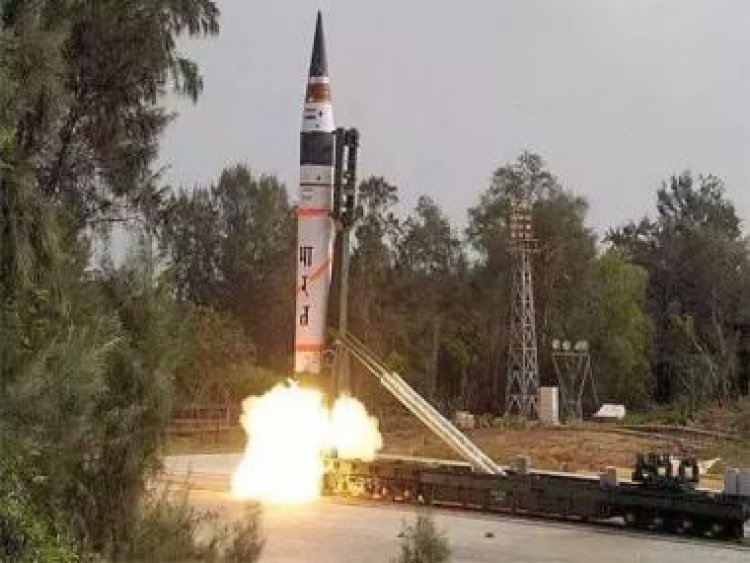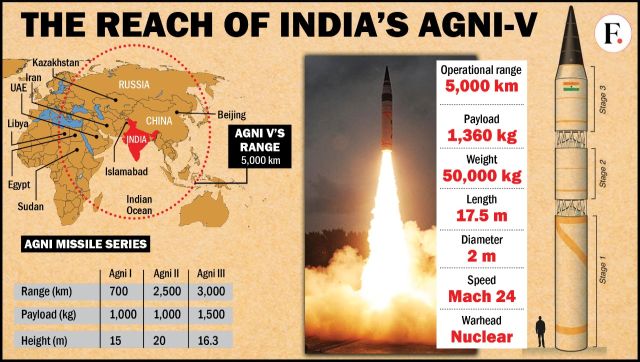Explained: The significance of the Agni-V missile trial amid China clashes
Explained: The significance of the Agni-V missile trial amid China clashes

On Thursday, India successfully carried out the night trials of the nuclear-capable Agni-V missile from the Abdul Kalam Island off the coast of Odisha. Defence sources quoted by news agency ANI said that the test was carried out to validate new technologies and equipment on the missile that are now lighter than before.
Defence ministry sources were quoted as telling NDTV that this was the ninth flight of the Agni-V — a missile first tested back in 2012.
Incidentally, the trial comes at a time when India and China ties are at its lowest once again following the clash in the Tawang sector of Arunachal. Troops of India and China clashed there on 9 December, resulting in minor injuries to soldiers on both sides.
Officials commenting on the timing of the test said that the trial of the Agni-V missile was routine and it had been planned earlier, with India issuing a notice declaring the Bay of Bengal as a no-fly zone.
We take a closer look at the Agni-V, India’s first inter-continental ballistic missile (ICBM), and how it compares to China’s hypersonic missile.
All about the Agni-V
The Agni-V is the fifth variant of India’s long-range surface-to-surface ballistic missile. India has a long history with the Agni series of missiles, dating back to 1989. At the time, India had test-fired Agni-I, an Intermediate Range Ballistic Missile, with a range of around 1,000 km.
Subsequently, India has been developing the Agni missile and the fifth variant was first tested in 2012, with subsequent tests being conducted in 2013, 2015, 2016, 2018 and 2021.
The Agni-V missile has a maximum payload of around 1,360 kilogram and a range of 5,000 km — this range puts almost entire China within the missile’s target range. However, there are some experts that state that the actual range of the missile is 8,000 km. The Chinese have earlier stated that India is underplaying the capabilities of the missile to avoid tensions.

According to defence experts, what sets the Agni-V missile apart from its predecessors is that it launches from a sealed canister that reduces the time needed for launching. The Agni-V also has the potential to be launched via a submarine. Furthermore, its top speed stands at around Mach 24.
The Agni-V is also India’s first inter-continental ballistic missile — a guided missile that is designed to deliver nuclear warheads, although they could also deliver other payloads. With the Agni, India has joined the club of seven countries — United States, Russia, China, France, Israel, UK and North Korea — that possess this technology.
What is special about ICBMs is that they are much faster and have a greater range than other types of ballistic missiles. They can also be launched in different ways: from underground missile silos, submarines, heavy trucks, or mobile launchers on rails.
Agni-V vs China’s DF-ZF hypersonic missile
If India has the Agni-V missile, China has the DF-ZF hypersonic glide vehicle. For those unaware, a hypersonic missile is one that travels at speeds of Mach 5 and higher — five times faster than the speed of sound (3,836 mph), which is around one mile per second. They are highly manoeuvrable and do not follow a predictable arc as they travel. They are said to combine the speed of ballistic missiles with the manoeuvring capabilities of cruise missiles. The speed makes them hard to track compared to traditional missile tech.
Hypersonic missiles are of two variants: the Hypersonic Glide Vehicles (HGV) and Hypersonic Cruise Missiles. The HGV are launched from a rocket before gliding to the intended target while the hypersonic cruise missile is powered by air.
China’s DF-ZF HGV is an ultra-high-speed missile allegedly capable of penetrating US air defence systems based on interceptor missiles.
Experts state that the missile entered operational service in 2019, though some still question the capability of its targeting apparatus.
China’s hypersonic weaponry has the United States expressing concern, as according to the National Public Radio, the weapon could attack the US from an unexpected direction, such as the South Pole.
India-China ties
The testing of the Agni-V missile comes when India-China ties are at its lowest after the Tawang clash of 9 December.
Since then, tensions are running fraught with India carrying out IAF exercises in the eastern sector. Aircraft such as the Rafale, Chinook and Sukhois have taken to the skies, putting the Chinese on alert.
Sources have told The Print that Beijing has increased their state of alertness and have deployed airborne early-warning aircraft at its Shigatse airport.
Intelligence analyst Damien Symon, who goes by the popular twitter handle @detresfa, has mapped the increased Chinese activity which includes high deployment of long-range surveillance drones among others.
Here’s a quick look at China’s airforce deployments in Shigatse airport, Tibet as news of increased aerial activity is reported in Indian media, after the recent clash between both armies along their shared border #TawangClash #IndiaChina https://t.co/OgIeUFcoq8
— Damien Symon (@detresfa_) December 13, 2022
Reports have also emerged that China is constructing a new military base near the Line of Actual Control close to strategically important Pangong Tso in Ladakh.
With inputs from agencies
Read all the Latest News, Trending News, Cricket News, Bollywood News,
India News and Entertainment News here. Follow us on Facebook, Twitter and Instagram.
What's Your Reaction?


























































